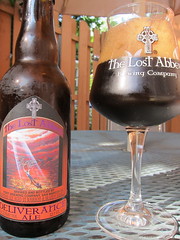Lost Abbey Deliverance Beer Review
The Lost Abbey, a brewery based in San Marcos California, views beer making as a call to arms. Their website reads like a brewer’s casus belli:
In the beginning there was Adam and Eve in the Garden of Eden. They were told not to eat the fruit from the apple tree. They were tempted by the serpent and made a “choice” to eat from the tree. Their actions were not preordained but rather the actions of beings with free will. At every fork in the road, there are signs marking the struggle of Good vs. Evil. The Lost Abbey was imagined as part of a crusade in this ongoing story of Good vs. Evil beer. Everywhere we turn these days, there is a battle being waged between those who make good beer and those who make evil beer.
For co-founder and head brewer Tomme Arthur, the goal to brew great beers in the Belgian style, is one to be taken religiously. Above their barrel room (an addition to the space after taking over from Stone in 2006) is a large sign that reads “In Illa Brettanomyces Nos Fides”; effectively ‘In Brett we trust’. For those unfamiliar, Brett is an aggressive genus of wild yeast found in wood and the skins of fruit. It can contribute to the spoilage of wine, but in low levels adds a desirable flavor element to both wine and many beers (think a Flanders red, Gueze, lambic or other sours).
I visited The Lost Abbey brewery in early 2012, and was struck by the massive amount of complexity and depth of their beers. Barrel aging and the precise addition of Brett take beers to levels not known outside of Belgium. This high level brewing has not gone unnoticed. Many of Lost Abbey’s beers sit amongst the top reviewed beers on websites like RateBeer.com and BeerAdvocate.com with their limited releases commanding huge amounts on the gray market.
For this review we take a taste of one of those top-rate beers, Lost Abbey Deliverance Ale. The beer is asctually a blend of two barrel aged beers, the Bourbon barrel-aged Serpent Stout, a rich imperial stout and Angel’s Share, a brandy barrel-aged English style barleywine. Each of these beers on its own is a flavor tour de force. Will the combination be an amalgamation for the ages, or a Stygian blend, destroying the greatness each beer possesses on its own?
TASTING NOTES
From the first opening of the cork (Lost Abbey bottles are hit with additional yeast then corked and caged) this bottle conditioned wonder gives an audible ‘pop’, indicating the carbonation has held up. The nose hints of its origins with vanilla, oak, berries, raisins, and roasted malt. The pour is dark brown, with a tan head.
I have only partial experience with the base beers, having sampled the excellent Serpent’s Stout on tap at Lost Abbey, sans barrel-aging, and later tasting a delicious but flat bottle of the Angel’s Share. Knowing how solid the blended beers were alone, the taste was greatly anticipated following such a bouquet. Deliverance did not disappoint. The first taste is massive dark chocolate, derived from the roasted malts of the bourbon barrel-aged Serpent’s Stout. Following chocolate, the palate turns to bourbon flavors, and dark fruits, with moderate carbonation carrying a medium body. The finish is slightly tart with hints of cherry and a gentle slap on the wrist from the well hidden 12.5% ABV. So much is going on.
CONCLUSION
As any craft beer aficionado will no doubt attest to, mixing even the most delicious beers together rarely leads to anything but foul hodgepodge, worse than the least of its parts. This blend of two titanic Lost Abbey beers by contrast, yields one of the most complex and satisfying ales I have ever tasted. Lost Abbey Deliverance is more than a stout, more than barleywine, it is in fact a masterpiece.


